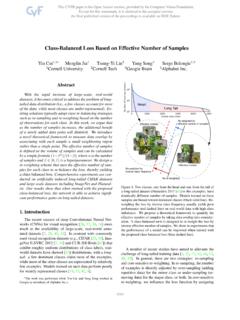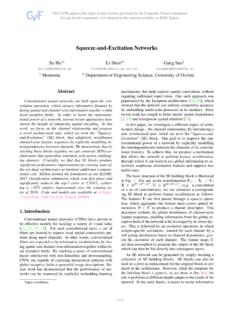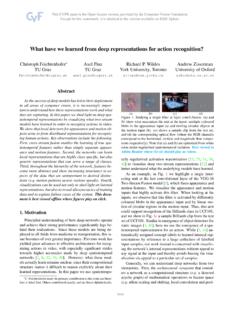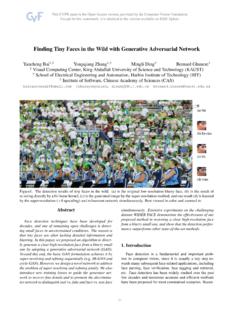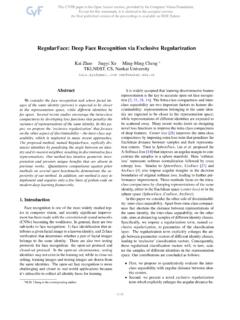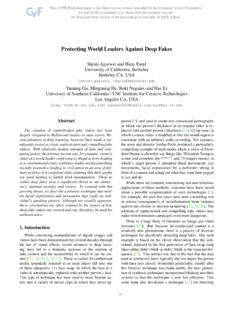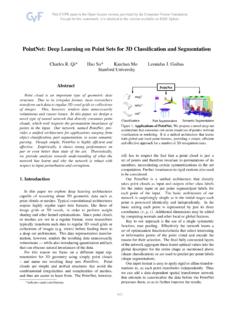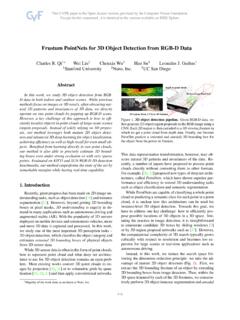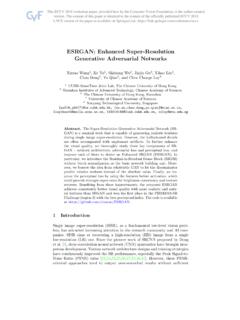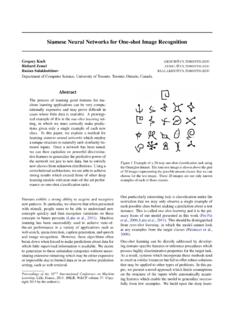Transcription of PointConv: Deep Convolutional Networks on 3D Point …
1 pointconv : deep Convolutional Networks on 3D Point CloudsWenxuan Wu, Zhongang Qi, Li FuxinCORIS Institute, Oregon State Universitywuwen, qiz, images which are represented in regular densegrids, 3D Point clouds are irregular and unordered, henceapplying convolution on them can be difficult. In this paper,we extend the dynamic filter to a new convolution opera-tion, named pointconv . pointconv can be applied on pointclouds to build deep Convolutional Networks . We treat con-volution kernels as nonlinear functions of the local coordi-nates of 3D points comprised of weight and density func-tions.
2 With respect to a given Point , the weight functionsare learned with multi-layer perceptron Networks and den-sity functions through kernel density estimation. The mostimportant contribution of this work is a novel reformula-tion proposed for efficiently computing the weight functions,which allowed us to dramatically scale up the network andsignificantly improve its performance. The learned convo-lution kernel can be used to compute translation-invariantand permutation-invariant convolution on any Point set inthe 3D space.
3 Besides, pointconv can also be used as de-convolution operators to propagate features from a subsam-pled Point cloud back to its original resolution. Experimentson ModelNet40, ShapeNet, and ScanNet show that deepconvolutional neural Networks built on pointconv are ableto achieve state-of-the-art on challenging semantic segmen-tation benchmarks on 3D Point clouds. Besides, our exper-iments converting CIFAR-10 into a Point cloud showed thatnetworks built on pointconv can match the performance ofconvolutional Networks in 2D images of a similar IntroductionIn recent robotics, autonomous driving and vir-tual/augmented reality applications, sensors that can di-rectly obtain 3D data are increasingly ubiquitous.
4 This in-cludes indoor sensors such as laser scanners, time-of-flightsensors such as the Kinect, RealSense or Google Tango,structural light sensors such as those on the iPhoneX, aswell as outdoor sensors such as LIDAR and MEMS capability to directly measure 3D data is invaluable inthose applications as depth information could remove a lotof the segmentation ambiguities from 2D imagery, and sur-face normals provide important cues of the scene 2D images, Convolutional neural Networks (CNNs)have fundamentally changed the landscape of computer vi-sion by greatly improving results on almost every visiontask.
5 CNNs succeed by utilizing translation invariance, sothat the same set of Convolutional filters can be applied onall the locations in an image, reducing the number of param-eters and improving generalization. We would hope suchsuccesses to be transferred to the analysis of 3D data. How-ever, 3D data often come in the form of Point clouds, whichis a set of unordered 3D points , with or without additionalfeatures ( RGB) on each Point . Point clouds are un-ordered and do not conform to the regular lattice grids asin 2D images.
6 It is difficult to apply conventional CNNs onsuch unordered input. An alternative approach is to treat the3D space as a volumetric grid, but in this case, the volumewill be sparse and CNNs will be computationally intractableon high-resolution this paper, we propose a novel approach to performconvolution on 3D Point clouds with non-uniform note that the convolution operation can be viewed as adiscrete approximation of a continuous convolution opera-tor. In 3D space, we can treat the weights of this convolutionoperator to be a (Lipschitz) continuous function of the local3D Point coordinates with respect to a reference 3D continuous function can be approximated by a multi-layer perceptron(MLP), as done in [33] and [16].
7 But thesealgorithms did not take non-uniform sampling into propose to use an inverse density scale to re-weight thecontinuous function learned by MLP, which corresponds tothe Monte Carlo approximation of the continuous convo-lution. We call such an operationPointConv. PointConvinvolves taking the positions of Point clouds as input andlearning an MLP to approximate a weight function, as wellas applying a inverse density scale on the learned weightsto compensate the non-uniform naive implementation of pointconv is memory inef-ficient when the channel size of the output features is verylarge and hence hard to train and scale up to large order to reduce the memory consumption of pointconv .
8 19621we introduce an approach which is able to greatly increasethe memory efficiency using a reformulation that changesthe summation order. The new structure is capable of build-ing multi-layer deep Convolutional Networks on 3D pointclouds that have similar capabilities as 2D CNN on rasterimages. We can achieve the same translation-invariance asin 2D Convolutional Networks , and the invariance to permu-tations on the ordering of points in a Point segmentation tasks, the ability to transfer informa-tion gradually from coarse layers to finer layer is , a deconvolution operation [24] that can fully lever-age the feature from a coarse layer to a finer layer is vital forthe performance.
9 Most state-of-the-art algorithms [26,28]are unable to perform deconvolution, which restricts theirperformance on segmentation tasks. Since our PointConvis a full approximation of convolution, it is natural to ex-tend pointconv to a PointDeconv, which can fully untilizethe information in coarse layers and propagate to finer lay-ers. By using pointconv and PointDeconv, we can achieveimproved performance on semantic segmentation contributions of our work are: We propose pointconv , a density re-weighted convolu-tion, which is able to fully approximate the 3D continuousconvolution on any set of 3D points .
10 We design a memory efficient approach to implementPointConv using a change of summation order technique,most importantly, allowing it to scale up to modern CNNlevels. We extend our pointconv to a deconvolution ver-sion(PointDeconv) to achieve better segmentation show that our deep network built on Point -Conv is highly competitive against other Point cloud deepnetworks and achieve state-of-the-art results in part segmen-tation [2] and indoor semantic segmentation benchmarks[5]. In order to demonstrate that our pointconv is indeeda true convolution operation, we also evaluate PointConvon CIFAR-10 by converting all pixels in a 2D image into apoint cloud with 2D coordinates along with RGB featureson each Point .
